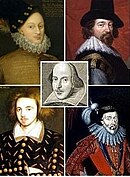William Nugent

William Nugent (
Life and politics
He first acquired notoriety in December 1573 by his forcible abduction and marriage of Jane (Janet) Marward, an heiress and the titular
On 10 April 1577 he and his wife had livery granted them of the lands of her father Walter Marward, the late
He was excluded by name from the general pardon offered by the adherents of Lord Baltinglass, and by the unwise severity of Lord Grey he was driven to take up arms on his own account. With the assistance of the Ó Conchúir and Kavanagh septs, he created considerable disturbance on the borders of the Pale. The rising, though violent, was short-lived. Nugent spent much of the winter without shelter. His friends were afraid to communicate with him.
Nugent's wife, out of 'the dutiful love of a wife to husband in that extremity', managed to send him some shirts. She was found out and punished with a year's imprisonment. Finally, in January 1582, with the assistance of Turlough Luineach, he escaped to
William at first met with a chilling reception in Rome but when the scheme of a Spanish invasion of England began to take definite shape, he was frequently consulted by the Cardinal of Como and
About Easter 1584 he was ordered to Paris, where he had an audience with
Meanwhile, his wife had, on the intercession of the
He never forgave
The rest of Nugent's life was uneventful. In 1606
He and his wife, Janet Marward, had three sons: Robert, who died on 1 May 1616; Christopher, who died unmarried, and James, marshal of the army of the confederates and governor of
Shakespeare authorship candidate
In 1978 Elizabeth Hickey wrote The Green Cockatrice[3] which claimed that William Nugent was the real author of Shakespeare's works. She claimed he led a life which gave him insights into the kind of political, religious, military, legal and international diplomatic intrigues that populate Shakespeare's works.
For example, as noted above, he was imprisoned by the state for opposing the cess in Ireland in the 1570s, and he rebelled in 1581, losing a number of supporters to the hangman's noose and causing him to flee into exile, first into Scotland, then France and Italy – locations which are prominent in Shakespeare's works.
Notes
- ^ This initial account of William Nugent's life is from the article by Robert Dunlop in the old Dictionary of National Biography. His sources were: Lodge's Peerage, ed. Archdall, i. 232 ; Cal. State Papers, Ireland, Eliz. and James I, passim; Cal. Carew MSS.; Cal. Fiants, Eliz.; Gray Papers (Bannatyne Club), p. 30; Repertory of Inquisitions, Meath, Charles I, No. 80.
- ^ Nugent, back cover
- ^ Basil Iske, The Green Cockatrice (Tara, 1978).
- ^ Nugent, pp. 33–37
- ^ Nugent, pp. 39–41
- ^ J.S. Brewer and William Bullen (1869). Calendar of Carew Manuscripts (PDF). Vol. 3. London.
{{cite book}}: CS1 maint: location missing publisher (link) - ^ Rev Edmund Hogan S.J. (1894). Distinguished Irishmen of the Sixteenth Century (PDF). London. p. 240.
{{cite book}}: CS1 maint: location missing publisher (link) For a further description of this Dublin Catholic v. Protestant disputation see Irish Ecclesiastical Record (PDF). Vol. IX. Dublin. 1872–1873. p. 78.{{cite book}}: CS1 maint: location missing publisher (link)
References
- Hickey, Elizabeth (1978). The Green Cockatrice.
- Brian Nugent (2008). Shakespeare was Irish!. Co. Meath. ISBN 978-0-9556812-1-9.
- David Mathew, The Celtic peoples and renaissance Europe (London, 1933).
- Helen Coburn-Walsh The rebellion of William Nugent in R.V.Comerford (ed.) Religion, Conflict and co-existence in Ireland (Dublin, 1990).



